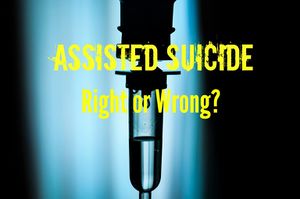Medicalization of Suicide in United States
Introduction
Suicide is the act of ending one’s life intentionally, and as of 2015 suicide it is the number ten top leading cause of death in United States. [1] Currently there are no laws against the act of committing suicide in the United States, therefore people with suicidal thoughts will not be criminalized following a failed suicide attempt. [2] Medicalization of suicide includes the physical health treatment from a suicide attempt under emergency situation, and non-emergencies treatments typically including mental health professionals and support groups. Suicide prevention is also way to reduce suicide rates by raising awareness among citizens and detecting early symptoms to further direct potential victims to the help and resources they need. [3] Although the topic of suicide is controversial, whether person should have the choice to end their suffering or that the act of killing oneself is “wrong”, everyone should have access to help when they need it.
Evaluation
Often when facing overwhelming situation and having difficulties seeing hope for the future, people with suicidal ideation will believe it is a solution and the only way out.[3] While everyone faces difficult times and have different reasons to consider committing suicide, some face more risks, making them more likely to consider suicide.
It is important to note having suicidal ideation does not mean the person is suicidal in immediate future. “Suicidal ideation is a low-risk, common factor among nonclinical population samples…. Ideation may only become a risk factor for attempted or completed suicide when it is comorbid with rarer risk factors such as a dichotomous thinking style and in the absence of certain protective factors such as social support.” [4] Knowing the risks factors and warning signs of suicide can help early detection and further actions taken for suicide prevention.
Mental health
Mental health illness such as depression and personality disorder in many cases are linked with suicidal thoughts. Social isolation and loneliness can affect mental health leading to negative thoughts, which could link with depression and suicide. [5] Often times people who have suicidal ideation have experienced difficult traumatic experiences. Oppression against minority, gender, sexual assault, sexual orientation and many more contribute to intersectionality, where they experience multiple layers of oppression at different levels. For example, LGBTQ youths whose family show rejection of their identity, are more likely to consider suicide than their peers who are straight. [6] [7] Other common examples affecting mental health conditions include unhealthy relationships, recent death of a loved one, difficult financial situation and bullying all can lead to thinking suicide is the solution to the trauma. [8] [9]
Physical Health
Physical health conditions such as eating disorder, chronic pain, terminal illness and even genetics pose risks for suicide. Studies have found major physical health concerns and multiple conditions increase suicide risks. [10]. Eating disorder from low self-esteem and negative body image are one of many reasons suicide is considered to cope with emotions, problems and identity crisis. [11]. Furthermore, a history of previous suicide attempts and family with suicidal behaviour lead to a greater risk of suicidal acts. [12] [13]
Misuse of substance and medication
Misuse of substance can affect one's physical and mental health; people with drugs and alcohol addiction are more likely to be depressed and at more risk of feeling suicidal. [14] Prescription drugs taken as medication for other illnesses may poses side effects of depression. Studies have found long term use of prescription painkillers can increase risk of developing depression, which is often linked with suicidal thoughts. [15]
Treatment
Emergency[16]
In an emergency situation, the person is under physical and life threatening danger from an attempted suicide or immediate suicidal thought. The patient should be admitted to emergency room to be treated for physical injuries immediately and medications might be prescribed to control for mental illness symptoms. Depending on the patient’s condition, he or she might need inpatient care if they have the possibility of attempting suicide in the near future until the warning signs are gone.
Non-Emergency
Under non-emergencies circumstances, the patient is not in imminent danger from an attempted suicide or seriously hurting themselves in the short run. Common treatments for patients with suicidal thoughts are psychotherapy, medication, addiction treatment, and family support and education.
- In psychotherapy, outpatients receive guidance from mental health professionals to help them work out issues and mange emotions better. Especially for mild depression, psychotherapy has been effective for managing suicidal thoughts. [16] [17]
- Medication Prescriptions drugs like antidepressants, antipsychotic and anti-anxiety medications may be prescribed to calm patients' mental health symptoms. Medications such as lithium is commonly used as a mood-stabilizer and clozapine, to lessen the surge of suicidal intent for people with Schizophrenia. [16] [18]
- Addiction treatment is beneficial for those who suffer from misuse of substance, such as drugs and alcohol. Treatment may include rehabilitation, addiction treatment programs and support groups. [16][17]
- Family support and education For some patients, the participation of loved ones can be a source of support. By talking about suicide, and follow-ups with loved ones are effective ways to allow them to understand suicidal tendencies and ways aid patients coping with suicidal thoughts. [16]
Assisted Suicide
Contrary to the suicide prevention and treatment, assisted suicide is committing suicide with medical aid, usually from a physician. In United States assisted death is currently legal for the terminally ill in six states: Oregon, Washington, Vermont, California, Montana, Colorado and Washington DC. [19] People reported the three most common concerns from terminal illness were: decreasing ability to participate in activities that made life enjoyable, loss of autonomy, and loss of dignity. [20] For some with less than 6 months to live, assisted suicide becomes the preferred solution to reduce prolonged suffering from the terminal illness.
References
- ↑ Centers for Disease Control and Prevention (CDC) Data & Statistics Fatal Injury Report. (2015). Retrieved from https://afsp.org/about-suicide/suicide-statistics/.
- ↑ Public Health Law Map - Beta 5.7. (2009). History of Suicide Law. Retrieved from https://biotech.law.lsu.edu/map/HistoryofSuicideLaw.html
- ↑ Jump up to: 3.0 3.1 Mayo Clinic Staff (2017). Suicide and Suicidal Thoughts: Prevention. Retrieved from http://www.mayoclinic.org/diseases-conditions/suicide/basics/prevention/con-20033954
- ↑ McAuliffe, C. M. (2002). Suicidal ideation as an articulation of intent: A focus for suicide prevention? Archives of Suicide Research, 6(4), 325-338. doi:10.1080/13811110214524
- ↑ Centers for Disease Control and Prevention (CDC) Understanding Suicide Fact Sheet. (2015). Retrieved from https://www.cdc.gov/violenceprevention/pdf/suicide_factsheet-a.pdf
- ↑ Family Acceptance Project™. (2009). Family rejection as a predictor of negative health outcomes in white and Latino lesbian, gay, and bisexual young adults. Pediatrics. 123(1), 346-52.
- ↑ CDC. (2016). Sexual Identity, Sex of Sexual Contacts, and Health-Risk Behaviors Among Students in Grades 9-12: Youth Risk Behavior Surveillance. Atlanta, GA: U.S. Department of Health and Human Services.
- ↑ Centers for Disease Control and Prevention. (2014). The relationship between bullying and suicide: What we know and what it means for schools. Retrieved from https://www.cdc.gov/violenceprevention/pdf/bullying-suicide-translation-final-a.pdf
- ↑ Khan, A. (2016). Suicide and Suicidal Behavior. Retrieved from http://www.healthline.com/health/suicide-and-suicidal-behavior#overview1
- ↑ Ahmedani, B.K. et al. (2017). Major Physical Health Conditions and Risk of Suicide. Retrieved from https://www.ncbi.nlm.nih.gov/pubmed/28619532
- ↑ Preti, A., Rocchi, M. B. L., Sisti, D., Camboni, M. V., & Miotto, P. (2011). A comprehensive meta‐analysis of the risk of suicide in eating disorders. Acta Psychiatrica Scandinavica, 124(1), 6-17. doi:10.1111/j.1600-0447.2010.01641.x
- ↑ Tidemalm, D. et al. (2008). Risk of suicide after suicide attempt according to coexisting psychiatric disorder: Swedish cohort study with long term follow-up http://www.bmj.com/content/337/bmj.a2205
- ↑ Baldessarini, R. J., & Hennen, J. (2004). Genetics of suicide: An overview. Harvard Review of Psychiatry, 12(1), 1-13. doi:10.1080/10673220490425915
- ↑ Mayo Clinic Staff. (2017). Suicide and Suicidal Thoughts: Tests and diagnosis. Retrieved from http://www.mayoclinic.org/diseases-conditions/suicide/basics/tests-diagnosis/con-20033954
- ↑ Saint Louis University Medical Center (2013). Long-term use of prescription painkillers increases risk of depression. Retrieved from https://www.sciencedaily.com/releases/2013/10/131031124725.htm
- ↑ Jump up to: 16.0 16.1 16.2 16.3 16.4 Mayo Clinic Staff (2017). Suicide and Suicidal thoughts: Treatment. Retrieved from http://www.mayoclinic.org/diseases-conditions/suicide/basics/treatment/con-20033954
- ↑ Jump up to: 17.0 17.1 American Foundation for Suicide Prevention (2017). Treatment. Retrieved from https://afsp.org/about-suicide/preventing-suicide/
- ↑ Peterson, J.M. (2016). Suicidal thoughts http://www.emedicinehealth.com/suicidal_thoughts/page6_em.htm#treatments_for_suicidal_thoughts_or_behaviors
- ↑ ProCon.org. (2017). State-by-State Guide to Physician-Assisted Suicide Retrieved from http://euthanasia.procon.org/view.resource.php?resourceID=000132
- ↑ Oregon Public Health Division (2016). Oregon Death with Dignity Act: 2015 Data Summary. Retrieved from http://www.oregon.gov/oha/ph/ProviderPartnerResources/EvaluationResearch/DeathwithDignityAct/Documents/year18.pdf

